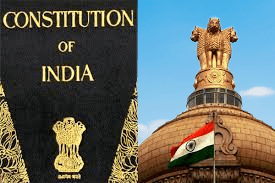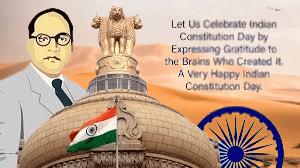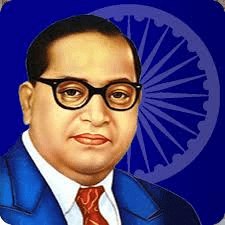Constitution Day of India: Constitution Day also known as “National Law Day” is celebrated in India on 26 November every year to commemorate the adoption of the Constitution of India. This day is also called as the “SAMVIDHAN DIVAS”.

Constitution Day of India
Dr. B. R. Ambedkar is known as the “Father of Indian Constitution”. Though India became a free nation on August 15, 1947, it declared itself a Sovereign, Democratic and Republic state with the adoption of the Indian Constitution on January 26, 1950.
In 1934, the demand of the Constituent Assembly was made. Let us tell you that M.N. Roy, a communist party leader, was the first who mooted the idea. It was taken up by the Congress party and finally, in 1940, the demand was accepted by the British government. Indians are allowed to draft the Indian Constitution in the August offer.
On 9 December 1946, the Constituent Assembly for the first time met before independence. The first president of the Constituent Assembly was Dr. Sachchidananda Sinha. On 29 August 1947, a Drafting Committee was constituted to prepare a Draft Constitution with Dr. B.R. Ambedkar as a Chairman. On 26 November 1949, the Committee finished its work. On 24 January 1950, the process was completed when the members signed two handwritten copies of the document one each in Hindi and English.

The first meeting of the Assembly was in New Delhi on 9 December 1946 and last till 24 January 1950. During this time total of 11 sessions were held and met for around 166 days. This is the period between the adoption and enforcement when thorough reading and translation from English to Hindi were done.
On 26 November 1949, the Constituent Assembly of India adopted to the Constitution of India, and it came into effect on 26 January 1950.
The Government of India declared 26 November as Constitution Day on 19 November 2015 by a gazette notification.
The Prime Minister of India Narendra Modi made the declaration on 11 October 2015 while laying the foundation stone of the B. R. Ambedkar’s Statue of Equality memorial in Mumbai.
The year of 2023 will be the 133rd birth anniversary of Ambedkar, who had chaired the drafting committee of the Constituent Assembly and played a pivotal role in the drafting of the constitution by which he became known as the Father of Indian Constitution.
Previously this day was celebrated as National Law Day. Reading the Preamble to the Constitution is an important part of the celebration and reaffirms our commitment to upholding its ideology.
Preamble of the Constitution of India
WE, THE PEOPLE OF INDIA,
having solemnly resolved to constitute India into a SOVEREIGN SOCIALIST SECULAR DEMOCRATIC
REPUBLIC and to secure to all its citizens:
JUSTICE, social, economic and political;
LIBERTY of thought, expression, belief, faith and worship;
EQUALITY of status and of opportunity;
and to promote among them all FRATERNITY assuring the dignity of the individual and
the unity and integrity of the Nation;
IN OUR CONSTITUENT ASSEMBLY this 26th day of
November, 1949, do HEREBY ADOPT, ENACT AND GIVE
TO OURSELVES THIS CONSTITUTION
Constitution of India
The Constitution of India declares India a sovereign, socialist, secular, democratic republic, assuring its citizens of justice, equality, and liberty and endeavors to promote fraternity. The preamble was amended by the 42nd Constitutional Amendment Act in 1976, in which three new words Socialist, Secular, and Integrity were added.
The Indian Constitution describes the fundamental political code, structure, procedures, powers, and duties of the government institutions. It also explains fundamental rights, directive principles, and the duties of citizens. India’s constitution is the longest-written constitution in the world. It took around 2 years, 11 months, and 17 days to complete the Constitution.
Fundamental Rights
The Fundamental Rights are called Fundamental because they are essential and natural to the development of human beings. The Fundamental Rights are defined as basic human freedoms that every Indian citizen has the right to enjoy for a proper and harmonious development of personality.
The Constitution offers all citizens, individually and collectively, some basic freedoms. These are guaranteed in the Constitution in the form of six broad categories of Fundamental Rights, which are justifiable. Article 12 to 35 contained in Part III of the Constitution deal with Fundamental Rights. These are:
- Right to equality, including equality before law, prohibition of discrimination on grounds of religion, race, caste, sex or place of birth, and equality of opportunity in matters of employment.
- Right to freedom of speech and expression, assembly, association or union, movement, residence, and right to practice any profession or occupation (some of these rights are subject to security of the State, friendly relations with foreign countries, public order, decency or morality).
- Right against exploitation, prohibiting all forms of forced labour, child labour and traffic in human beings.
- Right to freedom of conscience and free profession, practice, and propagation of religion.
- Right of any section of citizens to conserve their culture, language or script, and right of minorities to establish and administer educational institutions of their choice; and
- Right to constitutional remedies for enforcement of Fundamental Rights.
The Constitution of India is the supreme law of India. Parliament cannot override the constitution. The original 1950 constitution is preserved in a nitrogen-filled case at the Parliament House in New Delhi.
The Indian constitution is the world’s longest for a sovereign nation. At its enactment, it had 395 articles in 22 parts and 8 schedules. At about 145,000 words, it is the second-longest active constitution after the Constitution of Alabama in the world.
The amended constitution has a preamble and 470 articles, which are grouped into 25 parts, With 12 schedules and five appendices. It has been amended 105 times; the latest amendment became effective on 15 August 2021.
B. R. Ambedkar
Dr Bhimrao Ambedkar is known as the father of Indian constitution. On 29 August 1947, the Constituent Assembly set up a Drafting Committee. This Drafting Committee was headed by Ambedkar.

He was the then Law Minister who introduced the final draft of the Constitution in the Constituent Assembly. He took a very prominent part in the deliberations of the Assembly. Furthermore, he was known for his logical, forceful and persuasive arguments in the Constituent Assembly.
Popularly known as Babasaheb, this brilliant writer, constitutional expert, leader of scheduled castes is known as the ‘chief architect of the Constitution of India’. Dr Ambedkar is also known as a ‘Modern Manu’.
Bhimrao Ramji Ambedkar was an Indian jurist, economist, social reformer and political leader who headed the committee drafting the Constitution of India from the Constituent Assembly debates, served as Law and Justice minister in the first cabinet of Jawaharlal Nehru, the first prime minister of India.
He was a graduate from Elphinstone College, University of Bombay, Columbia University(Economics) and the London School of Economics, receiving doctorates in 1927 and 1923, respectively. He also trained in the law at Gray’s Inn, London.
In 1990, the Bharat Ratna, India’s highest civilian award, was posthumously conferred on Ambedkar.
Statue of Equality(Ambedkar)
The Statue of Equality also known as the Dr. Babasaheb Ambedkar Memorial is a monument under-construction dedicated to B. R. Ambedkar, the 20th-century Indian intellectual and the father of the Indian Constitution. The statue will be located at Indu Mills Compound in Mumbai in the Indian state of Maharashtra.
The statue of Babasaheb Ambedkar will be 137.3-metre (450 ft) in total height, including a 30.5-metre (100 ft) pedestal. The Ambedkar statue will be the third tallest statue in the world after the Statue of Unity (182 m) and the Spring Temple Buddha (153 m).
The foundation stone was laid on 11 October 2015 by Prime Minister Narendra Modi. On 10 March 2018, newspapers in India reported that the contract for the construction of the statue had been awarded to the Shapoorji Pallonji Group at a cost of ₹783 crores.

Its main attraction will be a 25,000 sq ft stupa around a pond. A dome-like structure with 24 stone ribs will be in the middle of plot. There will be an Ashoka Chakra covering the memorial structure. There will also be a proposed 39,622 square feet interactive museum displaying several aspects of Baba Saheb Dr. Ambedkar’s life. The memorial will have a facility to park around 400 vehicles.
The stupa would be the most expensive part at ₹110.95 crore (US$14 million). It will be 140 feet (43 m) tall with a circumference of 110 metres (360 ft). It will have a ribbed ceiling thus resembling the Buddhist Chaityas. An eight-tier bronze canopy representing the Buddha’s eight-fold path at the top of the stupa in a built-up area of 2,400 square metres with a lotus pond at the foot of the dome.
There is also a proposed Vipassana (meditation) Hall at the memorial with a seating capacity for 13,000 people.
The Gallery of Struggle will depict momentous events associated with the life and work of Ambedkar, alongside 50,000 square feet library.
Few days back, the tallest statue of Dr BR Ambedkar outside India was inaugurated in the US state of Maryland on October 14′ 2023. Ambedkar was the principal architect of India’s Constitution and played a crucial role in advocating equal rights for the Dalit community in India.
The statue has been sculpted by artist Ram Sutar, also known for his work on the Sardar Patel statue, called the Statue of Unity, installed on an island in Narmada, downstream of the Sardar Sarovar Dam in Gujarat.
The Ambedkar International Center (AIC), sprawling across 13 acres in Accokeek township, will encompass facilities like a library, convention centre, and Buddha Garden. Speaking after the statue unveiling ceremony, Ram Kumar, the president of AIC, stated that it is being called the equality statue because the issue of inequality is present in various forms worldwide and is not just limited to India.
Referred to as the “Statue of Equality,” over 500 Indian Americans from various parts of the United States and some attendees from India and other countries were present at the unveiling ceremony of the 19-foot tall statue amidst chants of “Jai Bhim.”
Ambedkar Jayanti is observed annually on 14th April in India to commemorate the birth anniversary of B. R. Ambedkar.